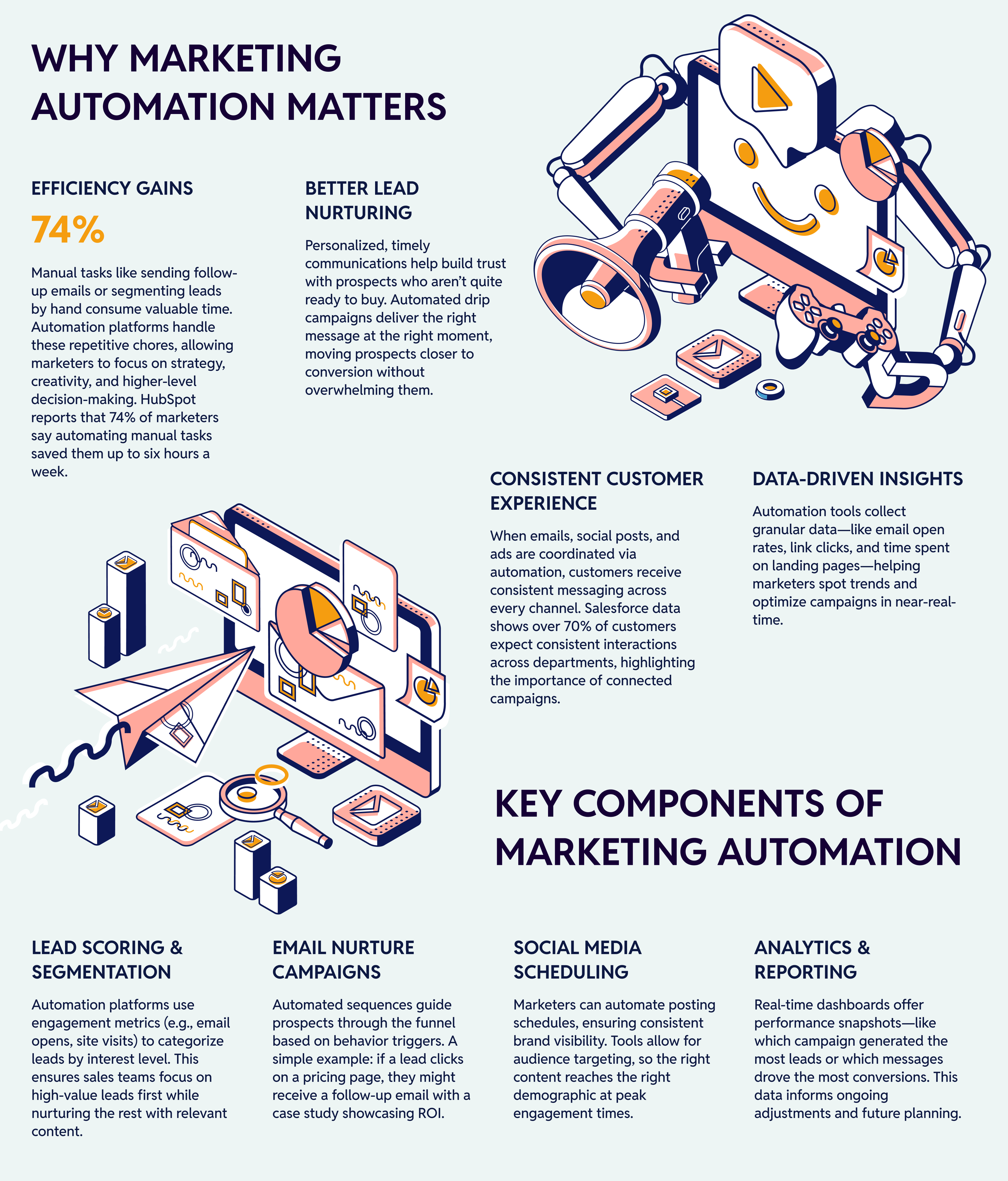Picture an inbox flooded with generic promotional emails that do little more than clutter the screen. Now imagine receiving a perfectly timed, personalized message that addresses your specific needs, just as you were ready to make a purchase. This contrast reflects the power of marketing automation—it replaces haphazard outreach with precise, data-driven campaigns that engage prospects at exactly the right moment.
According to a study by Forrester, marketers leveraging advanced automation see a 20% increase in sales opportunities¹. In today’s hyper-competitive environment, automation isn’t just a tool—it’s a strategic asset that can significantly elevate campaign performance. In this article, we’ll explore the fundamentals of marketing automation, share best practices for maximizing your ROI, and highlight how XMC360 helps businesses streamline campaigns from start to finish.


Why Marketing Automation Matters

Efficiency Gains
Manual tasks like sending follow-up emails or segmenting leads by hand consume valuable time. Automation platforms handle these repetitive chores, allowing marketers to focus on strategy, creativity, and higher-level decision-making. HubSpot reports that 74% of marketers say automating manual tasks saved them up to six hours a week².

Better Lead Nurturing
Personalized, timely communications help build trust with prospects who aren’t quite ready to buy. Automated drip campaigns deliver the right message at the right moment, moving prospects closer to conversion without overwhelming them.

Consistent Customer Experience
When emails, social posts, and ads are coordinated via automation, customers receive consistent messaging across every channel. Salesforce data shows over 70% of customers expect consistent interactions across departments, highlighting the importance of connected campaigns³.

Data-Driven Insights
Automation tools collect granular data—like email open rates, link clicks, and time spent on landing pages—helping marketers spot trends and optimize campaigns in near-real-time.
Key Components of Marketing Automation

Lead Scoring & Segmentation
Automation platforms use engagement metrics (e.g., email opens, site visits) to categorize leads by interest level. This ensures sales teams focus on high-value leads first while nurturing the rest with relevant content.

Email Nurture Campaigns
Automated sequences guide prospects through the funnel based on behavior triggers. A simple example: if a lead clicks on a pricing page, they might receive a follow-up email with a case study showcasing ROI.
Social Media Scheduling
Marketers can automate posting schedules, ensuring consistent brand visibility. Tools allow for audience targeting, so the right content reaches the right demographic at peak engagement times.

Analytics & Reporting
Real-time dashboards offer performance snapshots—like which campaign generated the most leads or which messages drove the most conversions. This data informs ongoing adjustments and future planning.
Best Practices for Getting Started

Define Clear Goals
Whether it’s increasing lead conversions, boosting average order value, or improving retention rates, set measurable objectives before launching automated workflows. This clarity guides every automation rule and creative choice.

Map the Customer Journey
Understand your buyer’s path—from initial awareness to decision—to create automation workflows that meet customers’ needs at each touchpoint. McKinsey research shows customer journeys are predictive of future behavior, underscoring the value of holistic planning⁴.

Personalize at Scale
Automation shouldn’t mean one-size-fits-all. Use segmentation and dynamic fields to tailor content, ensuring each lead feels recognized. Personalized emails can yield a 29% higher open rate⁵, according to Campaign Monitor.

Test & Refine Continuously
Launching a campaign is only half the battle—regularly review metrics, A/B test subject lines, or experiment with send times. Small tweaks can significantly improve overall performance.
How XMC360 Accelerates Marketing Automation
At XMC360, we understand that effective marketing automation is about more than just technology; it’s about orchestrating a unified, data-driven approach that resonates with your audience. Our platform offers:
End-to-End Workflow Integration
Unify lead capture, email nurturing, and social media campaigns within one interface. This eliminates the silos that often slow down marketing teams.
Customizable Drip Campaigns
Build automated sequences tailored to various buyer personas. With XMC360’s drag-and-drop interface, you can easily design and modify campaign flows without specialized coding skills.
Real-Time Analytics & Reporting
See exactly how each step of your workflow performs. Detailed metrics help pinpoint drop-off stages or highlight top-performing content, guiding continuous improvement.
Seamless CRM Sync
XMC360 integrates with leading CRM solutions, ensuring sales reps receive timely alerts about high-value leads, while marketers get a clearer view of lead progression.

Marketing automation transforms repetitive, labor-intensive tasks into a coherent, strategic engine for driving engagement and sales. By aligning automation efforts with well-defined goals, personalized content, and ongoing data analysis, you can deliver seamless campaigns that resonate with prospects at every stage of the funnel.
Through XMC360, businesses can unlock the full potential of automation—integrating processes, analyzing real-time performance, and continually refining each customer touchpoint for optimal results. Ready to streamline your campaigns and boost ROI? Contact XMC360 and let us show you how our platform can elevate your marketing strategy.
References:
- Forrester. (2019). The Total Economic Impact™ Of Marketing Automation.
- HubSpot. (2021). State of Marketing Trends Report.
- Salesforce. (2020). State of the Connected Customer Report.
- McKinsey & Company. (2021). Customer Journey Transformations.
- Campaign Monitor. (2020). Email Marketing Benchmarks.
